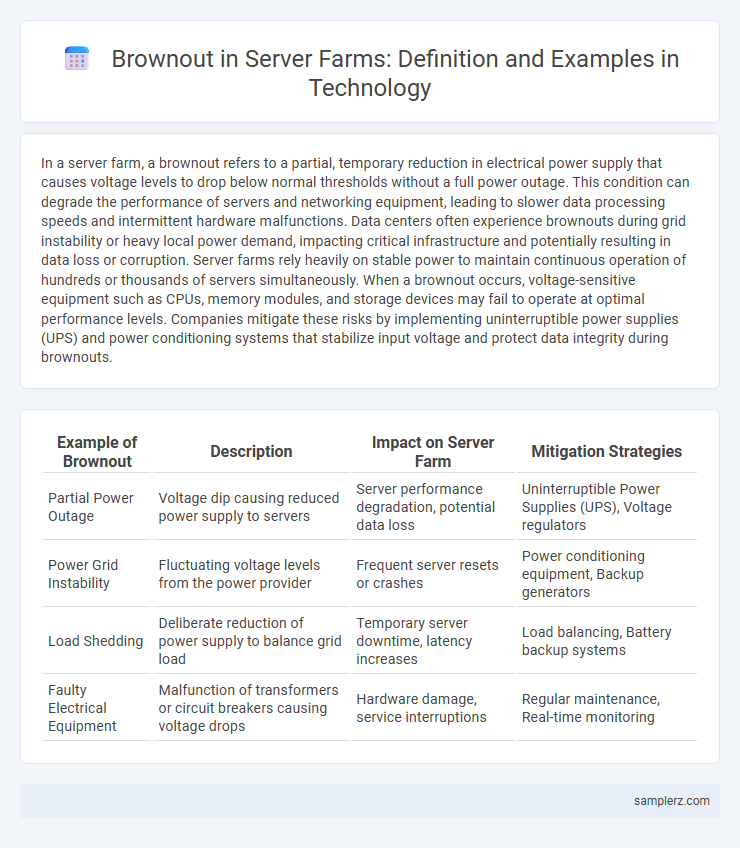In a server farm, a brownout refers to a partial, temporary reduction in electrical power supply that causes voltage levels to drop below normal thresholds without a full power outage. This condition can degrade the performance of servers and networking equipment, leading to slower data processing speeds and intermittent hardware malfunctions. Data centers often experience brownouts during grid instability or heavy local power demand, impacting critical infrastructure and potentially resulting in data loss or corruption. Server farms rely heavily on stable power to maintain continuous operation of hundreds or thousands of servers simultaneously. When a brownout occurs, voltage-sensitive equipment such as CPUs, memory modules, and storage devices may fail to operate at optimal performance levels. Companies mitigate these risks by implementing uninterruptible power supplies (UPS) and power conditioning systems that stabilize input voltage and protect data integrity during brownouts.
Table of Comparison
| Example of Brownout | Description | Impact on Server Farm | Mitigation Strategies |
|---|---|---|---|
| Partial Power Outage | Voltage dip causing reduced power supply to servers | Server performance degradation, potential data loss | Uninterruptible Power Supplies (UPS), Voltage regulators |
| Power Grid Instability | Fluctuating voltage levels from the power provider | Frequent server resets or crashes | Power conditioning equipment, Backup generators |
| Load Shedding | Deliberate reduction of power supply to balance grid load | Temporary server downtime, latency increases | Load balancing, Battery backup systems |
| Faulty Electrical Equipment | Malfunction of transformers or circuit breakers causing voltage drops | Hardware damage, service interruptions | Regular maintenance, Real-time monitoring |
Understanding Brownouts in Server Farms: Key Concepts
Brownouts in server farms occur when voltage supply drops below optimal levels without causing a full blackout, leading to reduced performance or server failures. This phenomenon often results from overloaded power grids, inefficient uninterruptible power supplies (UPS), or fluctuating renewable energy sources like solar and wind. Understanding brownouts involves monitoring voltage stability, implementing power conditioning equipment, and using adaptive server workloads to mitigate the impact on data center operations.
Common Causes of Brownouts in Data Centers
Brownouts in data centers commonly result from power supply fluctuations due to overloaded circuits, aging infrastructure, or faulty uninterruptible power supplies (UPS). Environmental factors such as heat, humidity, and poor ventilation can exacerbate electrical instability, increasing the risk of voltage drops. Equipment failures and maintenance errors also contribute to temporary voltage reductions, impacting server farm performance and reliability.
Real-World Brownout Scenarios in Server Farms
Real-world brownout scenarios in server farms often occur during partial power failures caused by grid instability or overloaded electrical infrastructure, leading to voltage drops that degrade server performance and cause intermittent shutdowns. Such events disrupt critical data processing and cloud services, compelling data centers to implement advanced uninterruptible power supplies (UPS) and voltage regulation systems to maintain uptime. Monitoring tools capable of detecting early brownout conditions enable proactive management, preventing hardware damage and minimizing service interruptions.
Impact of Brownouts on Server Performance and Uptime
Brownouts in server farms cause voltage drops that lead to reduced power supply, triggering server malfunctions and increased error rates. These voltage fluctuations degrade CPU performance and can cause unexpected reboots, resulting in significant downtime and loss of data integrity. Sustained brownouts compromise uptime reliability, forcing costly emergency maintenance and risking service-level agreement (SLA) violations.
Identifying Symptoms of Server Farm Brownouts
Server farm brownouts manifest as intermittent latency spikes, unexpected server reboots, and inconsistent data throughput rates, signaling partial power degradation rather than complete failure. Monitoring fluctuations in voltage levels across power distribution units (PDUs) helps identify these subtle power inconsistencies early. Key symptoms include increased error rates in application logs and non-uniform cooling system performance, which correlate strongly with reduced power quality affecting server hardware stability.
Case Study: Brownout Incident in a Major Server Facility
A brownout incident occurred in a major server facility when a partial voltage drop caused intermittent power fluctuations, leading to server performance degradation and temporary data access delays. The facility's uninterruptible power supply (UPS) system mitigated complete outages but failed to prevent hardware stress on storage arrays and network switches. Analysis revealed that the brownout originated from grid instability during peak load hours, emphasizing the need for enhanced power conditioning and real-time voltage monitoring in large-scale data centers.
Preventative Measures Against Brownouts in Server Farms
Server farms can experience brownouts, characterized by temporary voltage drops that disrupt server performance and risk data integrity. Implementing uninterruptible power supplies (UPS) alongside advanced voltage regulators stabilizes power flow and ensures continuous operation during voltage sags. Routine electrical infrastructure maintenance and real-time power quality monitoring systems detect abnormalities early, preventing potential brownout impacts on critical data center functions.
Role of Power Management Systems During Brownouts
Power management systems in server farms detect voltage sags during brownouts and dynamically reduce energy consumption by throttling non-essential workloads and adjusting cooling mechanisms. These systems coordinate with uninterruptible power supplies (UPS) to maintain critical operations and prevent hardware damage by stabilizing power delivery. Effective power management ensures continuous uptime and protects server infrastructure from voltage instability challenges inherent to brownouts.
Strategies for Recovering from Brownouts in Server Infrastructure
Server farms experiencing brownouts often deploy uninterruptible power supplies (UPS) and automatic transfer switches to maintain power stability and prevent data loss. Implementing dynamic load balancing and virtual machine migration helps redistribute workloads during voltage drops, ensuring continuous service availability. Recovery strategies also include real-time monitoring systems and automated failover protocols to quickly detect and respond to power fluctuations, minimizing downtime and hardware damage.
Future-Proofing Server Farms Against Brownout Risks
Brownouts in server farms, such as reduced voltage events causing intermittent power supply drops, significantly disrupt data center operations and elevate hardware failure risks. Implementing advanced uninterruptible power supply (UPS) systems combined with real-time voltage monitoring creates adaptive power management solutions that mitigate brownout impacts. Future-proofing server farms requires integrating AI-driven predictive analytics to anticipate brownout patterns and deploying edge computing clusters to maintain critical workload continuity during power anomalies.

example of brownout in server farm Infographic
 samplerz.com
samplerz.com